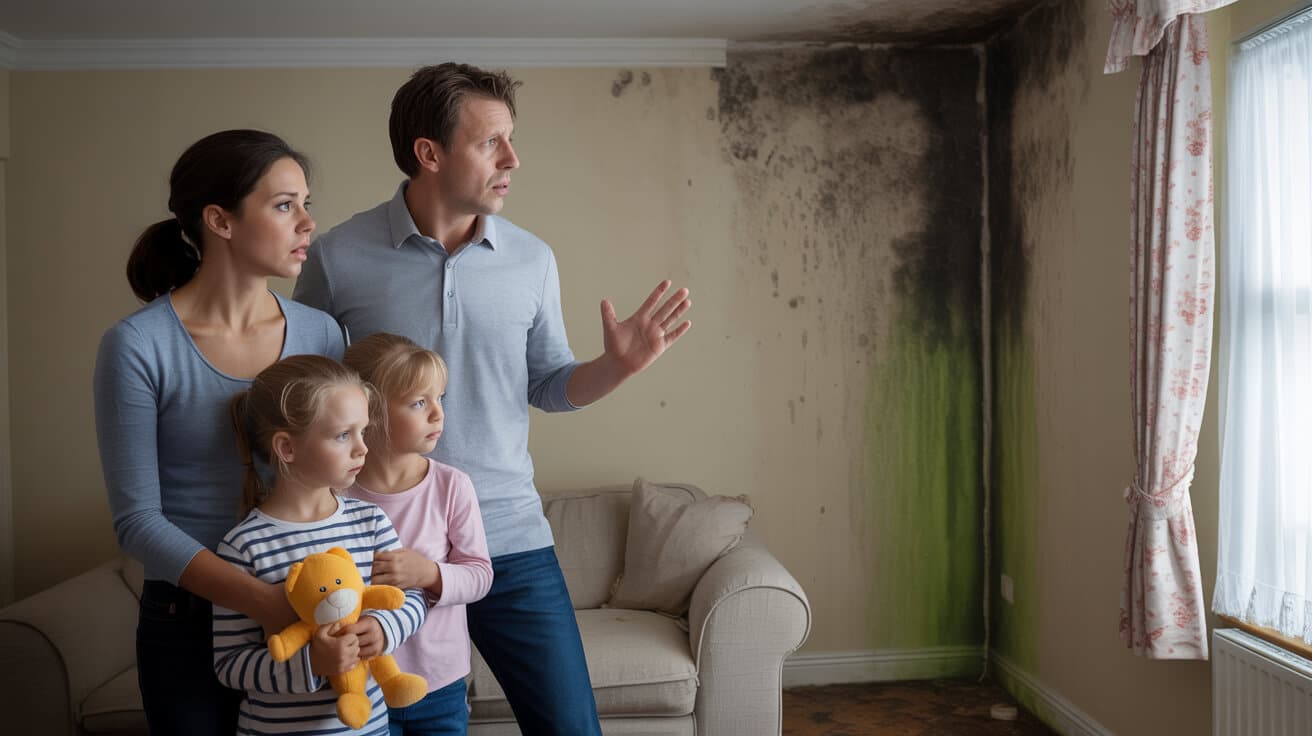 The High Cost Of Ignoring Damp And Mould Complaints
The High Cost Of Ignoring Damp And Mould Complaints

How Is Ignoring Damp and Mould Complaints Silently Destroying Your Property and Bottom Line?
Damp and mould don’t announce themselves with flashing lights—they creep in, quietly undermining both your asset and your reputation. For property owners, contractors, and facilities managers, dismissing or delaying these complaints often seems harmless at first glance. But this silence stacks up hidden costs faster than most realise, eating away at structural health, tenant goodwill, and, ultimately, your own bottom line.
Quiet neglect today becomes your most public—and expensive—problem tomorrow.
Let’s be real: every property has its moments. But in the UK’s current property landscape, letting a damp patch linger isn’t just risky—it’s hazardous to your returns and standing. Ignore that call or email, and you’re not just leaving a wall vulnerable; you’re leaving your record wide open for criticism from regulators, insurers, and tenants who are armed with smartphone evidence and council-backed support. Today’s “out of sight, out of mind” becomes tomorrow’s building survey headline—and it’s never good news.
Ownership isn’t about hoping for the best or brushing aside minor issues. It’s about forward momentum. Time and again, we’ve seen small spots of mould transform into multi-thousand-pound remediations simply because someone hoped the tenants were exaggerating or the issue would disappear. The real enemy isn’t the damp itself; it’s the delay. When a complaint sits unaddressed, water keeps moving, timber keeps softening, spores gather strength, and reputational risk compounds.
We’ve entered an era where hiding inaction isn’t an option. Property records are digital. Complaints are timestamped. The cost of silence, both in cash and credibility, is real—and rising.
Can Damp and Mould Actually Harm Tenant Health—or Is That Overstated?

There’s an old, stubborn belief floating around UK property circles: “It’s just a bit of mould; tenants need to open the window.” That’s not just outdated—it’s dangerous thinking. Health risks from damp and mould aren’t scare stories. They’re backed by NHS data and now drive public policy (NHS, gov.uk).
One out of every three tenant health complaints in the UK now ties directly to damp or mould.
You’re not just risking your asset when you ignore these signs. You’re putting real people at risk—children, elderly residents, anyone with asthma or compromised immunity. The health effects are well-documented: spores and airborne toxins from untreated damp increase cases of asthma, eczema, chronic cough, and absenteeism from work and school. What’s more, this isn’t just about the few visible patches on a wall—mould spreads in hidden spaces, producing effects long before you spot it on a site visit.
Also, consider this: tenants today have more legal firepower and informational resources than ever before. A single doctor’s note or NHS-backed claim in a housing complaint can accelerate council intervention, activate insurance triggers, or lead to expensive, time-sensitive remediation orders. By treating complaints as mere “tenant noise,” you’re gambling against medical consensus and, frankly, your own interests.
The bottom line is clear: protecting tenant health isn’t just ethical—it’s also the backbone of long-term, defensible property management.
What Are Your Legal and Financial Risks for Delaying Action?

Inaction isn’t just a poor health decision—it’s a legal liability. UK law is now unambiguous: landlords and facilities owners must act, not react, when faced with damp and mould complaints. Under the Landlord and Tenant Act 1985 and the Homes (Fitness for Human Habitation) Act 2018, your duty isn’t optional—it’s enforceable, and non-compliance is expensive (commonslibrary.parliament.uk).
No regulator is interested in excuses—only a timeline of what you did to fix the problem.
Here’s how delay turns into disaster: with council-backed reporting apps, every tenant has a direct line to authorities. The Housing Health and Safety Rating System (HHSRS) means authorities can act on the complaint alone—they don’t need to prove harm, just your delay. Landlords are being fined up to £30,000 per breach; some properties are even stripped from owners who repeatedly ignore complaints (moore-tibbits.co.uk).
Feeling reluctant to spend on early repairs? The penalty for waiting can include:
- Immediate rent freezes until repairs are complete
- Expensive, council-ordered remediation with no say on contractor or timeline
- Banning orders, stripping your ability to let future properties
- Long-term barriers with insurance, lenders, or future buyers due to public records of enforcement
A missed complaint, or a few weeks of inertia, can quickly escalate into tens of thousands lost—not to mention damage to your professional standing in a marketplace that tracks every outcome.
Can You Ignore a Complaint and Hope It Blows Over?

In a connected world, waiting for a problem to disappear is like waiting for rain to fix a leaky roof—it only compounds the issue. Thanks to digital property management systems and council apps, every complaint now creates an unalterable timeline that external parties—tribunals, ombudsman, even the next buyer—can follow.
More than two-thirds of tribunal disputes are won by tenants whose complaints were left lingering in the system.
A hands-off approach only works against you. When tenants log issues, supporting evidence piles up quickly: dated photos, council call logs, even group chats from other tenants in shared accommodations. Each week you stall, their leverage increases, and your own control over solutions shrinks. By the time you’re forced to act, you may have lost any choice in approach or contractor, often paying more for less efficient results.
Worse, unresolved damp issues rarely remain contained. Water and mould spread, so do tenant frustrations—which sometimes become public, showing up in online reviews or social forums, further eroding your asset’s reputation. At that point, you aren’t just dealing with one complaint—you’ve invited scrutiny, cost escalation, and permanent risk to your letting history.
Momentum always works both ways: act early, and you regain control; wait, and the process—and cost—outpaces you.
Why Does Delay Make Damp and Mould So Costly to Fix?

Here’s a hard truth: every day you pause, the cost curve bends against you. Early intervention—a prompt patch repair, quick anti-fungal treatment, or tracing a leak—costs a fraction of what delayed action demands (homehow.co.uk). A typical small-area repair may run £250–£400. After weeks or months of neglect, expect to multiply that—sometimes by a factor of four or more.
Every week you wait adds more than 20% to the eventual restoration bill.
Ignored, moisture doesn’t just darken paint; it saturates wall cavities, corrodes electrical components, and weakens flooring. What started as a minor fix expands into:
- Complete wall or floor replacement
- Advanced drying and decontamination
- Re-rendering exteriors or deep-cleaning ventilation systems
- Tenant relocation (and void periods) to allow safe repairs
Insurance rarely swoops in to save you, either. Most UK property insurance policies now exclude claims where a history of delayed action, ignored complaints, or evidence of “preventable” escalation exists. Loss adjusters comb through these records—it’s standard practice. Fail to act, and the price is paid out of your pocket, with little recourse.
Ultimately, acting quickly isn’t over-spending. It’s smart capital allocation—a way to lock in value and avoid giving away your margin to neglect.
How Does Neglect Affect Asset Value and Insurance Access?

Every unresolved complaint attaches a long tail to your property record. Digital letting logs, open-source council databases, and even tenant forums document the good, the bad, and the property risks that buyers and insurers increasingly review.
High-volume complaints now show up in property searches, reducing buyer interest and directly lowering achievable prices.
Letting agents, mortgage brokers, and insurers all check for unresolved or recurring damp and mould issues. A property flagged for delayed remediation or repeated council involvement often faces:
- Price reductions, even at the negotiation stage
- Refused or higher-premium insurance renewals
- Stricter mortgage terms or loss of access to the best deals
- Longer listing times and increased tenant turnover
And if you own a portfolio, beware: one black mark in a key property can affect loan terms or valuation rates across your other units. Where transparency in records is the new norm, prevention and quick action keep your portfolio attractive and insurable. It isn’t just about protecting bricks and mortar—it’s about safeguarding your leverage with every party in the property chain.
What Does Real Prevention and Professional Action Look Like?

Prevention isn’t wishful thinking, and it’s never “everyone’s job and no one’s.” Successful owners, agents, and facility managers now treat every complaint as a live case file, not a hassle to defer. The leader’s mindset? Proactive checks, prompt documentation, and routine communication—all ammo when defending your operation to regulators, insurers, or buyers.
The biggest property wins go to those who prevent, not just repair; who document, not just promise.
Here’s what elite prevention really means:
- Immediate logging: Every complaint is entered into a cloud-based record, with before/after images attached.
- Coordinated response: Not just sending a contractor, but confirming root cause is fixed, not just masked with paint or filler.
- Evidence-based follow-through: Each service is signed off and explained in plain language, ready for tenancy deposit disputes or council queries.
- Scheduled vulnerability checks: Quarterly reviews in high-risk units, humidity sensors in persistent cold rooms, and rapid mid-tenancy visits after heavy rainfalls.
- Transparent action with tenants: Keeping tenants in the loop reduces escalation and builds trust—they become allies, not adversaries.
The modern “gold standard” is transparent, fully-auditable property care. Quick fixes don’t win in the end—records and reliably closed cases do.
Why Is All Services 4U the First Call for Damp & Mould Issues?

Let’s call out the real change: today’s property risks need more than a “handyman in a van.” Owners, block managers, and corporate landlords demand end-to-end management—fast, compliant, and documented.
All Services 4U was built for this new landscape. Our team brings:
- Multi-trade, certified technicians: —City & Guilds, NVQ Level 3, DBS checked
- Rapid first response: —for both routine checks and midnight emergencies
- Photo-evidence workflows: —before and after every intervention, suitable for council submission or future insurance claims
- Code compliance: —from BS7671 electrics to the Fire Safety Order, audited and recorded
- Clarity-first communication: —every fix explained in real-world terms, so you and your tenants always know the plan
Tenants and insurers judge you by how you handle problems, not how you hope they disappear.
Booking repairs is easy—emergency and planned, with scheduled inspections and compliance checks built in. One call covers it all: inspection, root cause analysis, action, and evidence, all logged and packaged for your legal or financial needs.
We measure success not just by repairs done, but by headaches, fines, and tenant conflicts you never have to face.
Book Your Damp & Mould Assessment With All Services 4U Today
Here’s what experience—and hard numbers—teach us: every day not taking action gifts a little bit more of your property value, reputation, and future to decay and dispute. There is no neutral when it comes to damp and mould—every missed day is a drift towards higher bills, lost rental income, possible fines, and a deteriorated handshake with buyers, lenders, and insurers.
Ready to flip the script from reactive to proactive? With All Services 4U, prevention isn’t complicated. Certified technicians arrive on-site, document every step, fix the source, not just the surface, and back you up with proven, council-ready records. You control the process. You safeguard your asset. You prove to tenants, partners, and insurers that your operation is current, credible, and decisive.
Own your future—one prompt, professional repair at a time.
Don’t wait for a complaint to hit the public record or surprise you with a tribunal notice. Book your professional, fully-documented assessment with All Services 4U today. Stop risking unnecessary costs, and start building a reputation for smart, compliant management.
Call All Services 4U now to lock in peace of mind, proof of action, and total control—every day, in every property you own or manage.
Frequently Asked Questions
What emerging risks are making damp and mould a hard-to-ignore headache for owners and tenants in 2025?
Damp and mould aren’t just causing murky stains—they’re setting off a digital chain reaction that can tank health, wipe out property value, and leave a paper trail on every asset you manage. In 2025, NHS Digital found childhood asthma linked to mould is up 70% in UK rentals, and smart complaint logs now feed council, lender, and insurer databases in real time. The result? Unresolved issues don’t fade—they multiply, surfacing for years as visible “badges” to buyers and regulators.
A water stain isn’t just a spot on the wall—it’s a spotlight on your property record.
Who gets hit first—owners, tenants, or managers?
- Tenants: Chronic illness, higher school absence, stress, and risk of forced moves
- Property owners: Forced repairs, asset devaluation, legal orders, blocked sales, rising premiums
- Portfolio/facility managers: One flagged flat can drag loan and insurance rates for the entire block
What’s driving this risk spike?
- Live-published complaints: Cloud apps and council integrations mean nothing is “buried” anymore
- Instant enforcement flags: Local authorities issue “action now” orders for Category 1 hazards, not warnings
- AI logging: Anything not fixed and logged by a pro counts as unresolved—insurers and buyers check these records as routine
When inaction turns into a streak on your digital profile, the only fix is proactive, logged-by-experts remediation—documented for every stakeholder who matters. Owners ignoring today’s warning become tomorrow’s audit case study.
How have property compliance and legal obligations on damp and mould changed since 2025?
Landlords now face a new normal: annual, digital evidence-based “fitness for habitation” checks are part of the lease’s DNA, enforced not only by councils but by an open register referenced by lenders, insurers, and tenants. The Homes (Fitness for Human Habitation) Act requires visible and hidden damp/mould to be checked and logged, with all action completed by certified pros. Even a single missed check triggers a non-compliance risk visible to anyone with internet access.
| Regulation/Rule (2025+) | Absolute Requirement | Who’s Checking? |
|---|---|---|
| Fitness for Habitation Act | Annual check, digital repair evidence | Council, Lending Agent |
| ICO & Deregulation Amendments | GDPR-compliant digital complaint log | ICO, Local Authority |
| Updated HHSRS Regs | “Eliminate risk, don’t just respond” | Environmental Health |
Why do contracts no longer protect you?
- Law overrides agreements: Repair and safety can’t be shifted to tenants, even by request—legislation bans it
- Speed matters: You have 14 days to resolve complaints with professional verification—or you’re presumed liable
- Public records: Non-compliance lists are used by mortgage lenders, insurers, and tenant groups to make decisions
If it isn’t proven by your digital logbook, it’s presumed unfixed—contracts and phone calls don’t shield you anymore.
How does All Services 4U solve this compliance puzzle?
Professional, timestamped assessments and repair logs, with photo/video support, mean every step is audit-ready and compliant—protecting you from claims, fines, and costly “legacy” risks that threaten future sales.
What long-term financial and compliance risks follow if minor damp or mould is ignored?
What looks like a “small patch” is actually a financial domino. Each ignored sign makes future repairs pricier and public record sharper: according to the Royal Institution of Chartered Surveyors, average repair costs jump as much as 35% annually if left unchecked, and flagged records slash a property’s value by up to £50,000 when the next owner, buyer, or underwriter looks. Property agents now scan digital complaint logs as baseline due diligence.
Every skipped repair tells a storey—insurers and buyers are listening, and every word costs you.
What does the risk timeline look like?
- First 90 days: Risk of insurance excess hikes, deposit dispute, or flagged council review
- 6–12 months: Formal enforcement, rent repayment orders, portfolio-wide compliance flag
- 1–2 years: Invasive repairs, insurance drop, negative public records—resale value nosedives
What’s the hidden risk of repeat complaints?
Multiple unresolved reports trigger “systemic neglect” tags in local databases—raising fines and the probability of rent clawbacks or blocked licences. Inaction now follows your asset, not just your inbox.
Professional, time-stamped repairs with photographic logs have replaced “patch and hope.” All Services 4U ensures problems are solved and seen as solved—by every regulator, buyer, and insurer in the chain.
Which early signs should prompt property owners to get urgent, professional damp investigation?
Damp is getting smarter—digital logs, tenant apps, and sensor data all “see” more than eyes and noses. Musty odours and flaky paint are old news. The warning lights for urgent investigation now include fluctuating smart metre readings (humidity/temperature), unexplained energy bills, or persistent “cold spots” flagged by smart thermostats and tenant complaints—especially if symptoms tally across several rooms.
One quiet cough in a tenant’s log, or a single unexplained cold zone, can be the start of a compliance storm.
What demands immediate, professional attention?
- Smart metre or thermostat alerts for humidity or temperature dips:
- Condensation reappearing after fresh cleaning or redecoration:
- New bulges, blisters, or warping in walls or floors:
- Multiple complaints in a single digital log—crowdsourced or council-reported:
- Damp detected after recent roof, gutter, or pipe repair:
Why do DIY fixes rarely satisfy insurers or regulators?
Surface-only actions just mask root problems. Insurers now want before/after evidence, logged by professionals, or they’ll treat any eventual claim as “pre-existing and excluded.” Fast apps and council forms create a public record that chases after the property, not just the owner.
Commissioning a professional assessment with a full digital log—like those provided by All Services 4U—is now the new bar for compliance and asset defence.
How are insurers and lenders changing their due diligence for properties with damp or mould complaints?
Underwriting has entered the digital age. Applications demand disclosure of any complaints leading to repairs, and public council and tenant log data is live-cross-referenced—not just with surveys, but with real-time portfolio analytics. Insurers and lenders can now refuse cover, bump premiums, hold back lending, or impose portfolio-wide scrutiny on the strength of data from complaint logs and repair histories.
| Stakeholder | Digital Tripwire | Outcome |
|---|---|---|
| Insurer | Missed/DIY repair, open log | Cover restrictions, exclusions |
| Lender | Flagged council or tenant database | Delayed/denied lending |
| Buyer/Agent | Repair/complaint chains in logs | Price erosion, longer to sell |
What’s changed from pre-2025?
Blank or incomplete forms are now “voidable” events. Buy-to-let lenders and portfolio managers cross-match public data at the address level—one “bad” unit can impact valuations or borrowing power for the entire group. Fine print has shifted: if you can’t supply a digital, compliant, and professional log, access to cover or finance shrinks.
What’s the path of least resistance?
Rely on professional, cloud-archived records—not invoices alone. All Services 4U makes sure every fix is digitally logged, photo-documented, and passable for audit, keeping doors open to lending, insurance, and efficient sales.
Why does All Services 4U deliver more lasting value and compliance than standard “patch and paint” repairs?
All Services 4U does not just “fix and move on”—they treat every visit as a compliance upgrade and asset booster. City & Guilds, NVQ, and safety-registered professionals root out causes, not just symptoms, and deliver every step as digital evidence—making your property’s compliance and asset record bulletproof. Inspections, emergencies, and repairs end with a photographic, time-stamped log, ready for any auditor, insurer, or potential buyer or lender.
In 2025, your property’s paperwork speaks louder than its paintwork. Only logged, professional repairs build real long-term value.
What advantages does this approach offer property teams and owners?
- 24/7 responsive site visits: From emergencies to proactive checks, professional first-responders arrive fast
- Advanced tools for diagnostics: Pinpoint hidden leaks, insulation defects, and airborne moisture risk—all without major disruption
- Comprehensive reporting: Every job yields a ready-for-inspection digital summary with images and recommendations
- Full transparency on costs and timelines: No jargon, no invisible extras, just honest advice and projected lifecycle benefits
- Documentation as currency: Strong records translate to faster lending decisions, better tenant retention, and increased asset resale value
Ready to secure your compliance and financial future?
Book an assessment with All Services 4U and turn potential liabilities into strengths—compliance problems become proof of action, property worries flip into competitive advantages, and your role as a diligent, risk-limiting owner grows stronger with every logged repair.



